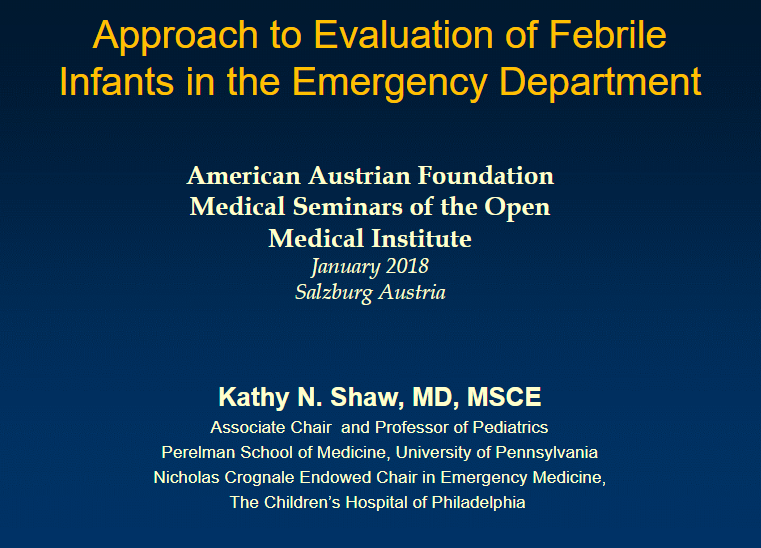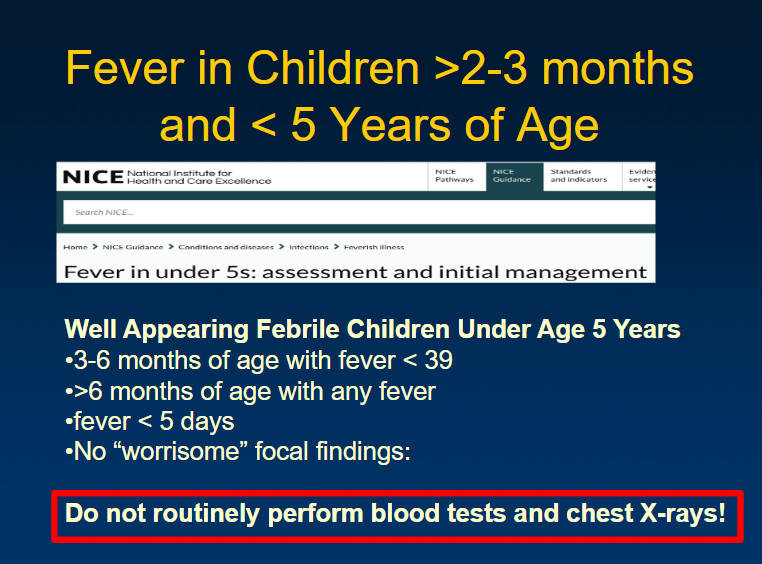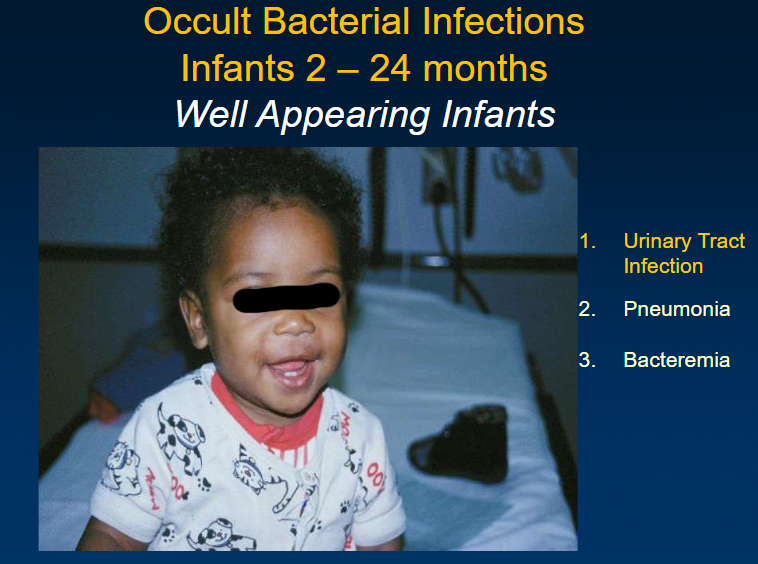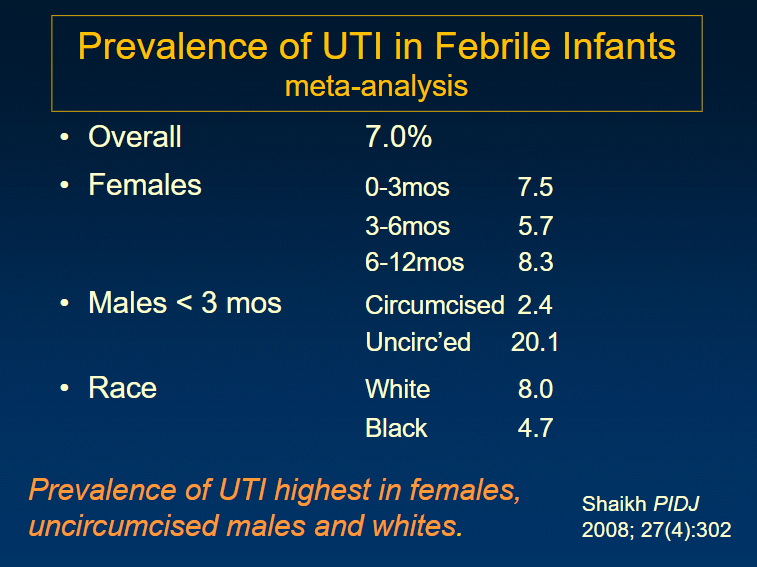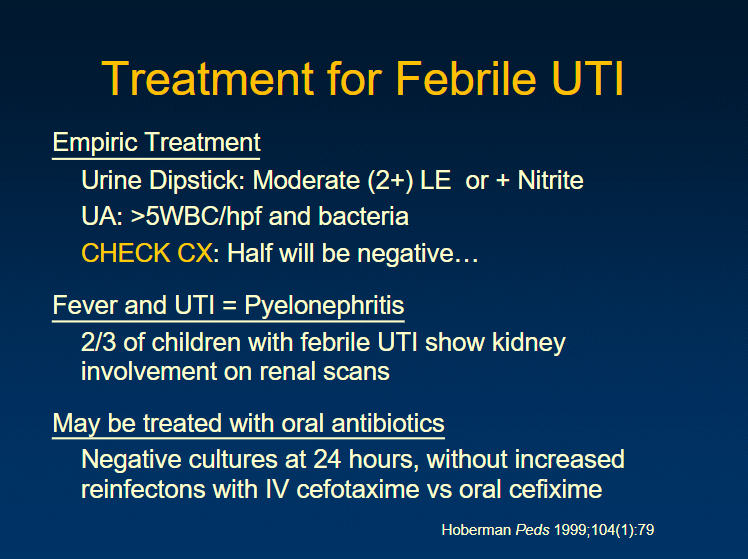This post is Evaluation Of The Well Appearing Febrile Infant From CHOP – Part 2 Of 4 – 2 to 24 Months – Occult Bacterial Infections – UTI from the outstanding Approach To Febrile Infants In The Emergency Department lecture and accompanying slides from The Children’s Hospital of Philadelphia (CHOP).
I’ve divided the above CHOP lecture into four posts:
- Evaluation Of The Well Appearing Febrile Infant From CHOP – Part 1 Of 4 – Less Than 60 Days Of Age
- Evaluation Of The Well Appearing Febrile Infant From CHOP – Part 2 Of 4 – 2 to 24 Months – Occult Bacterial Infections – UTI
- Evaluation Of The Well Appearing Febrile Infant From CHOP – Part 3 Of 4 – 2 to 24 Months – Pneumonia
- Evaluation Of The Well Appearing Febrile Infant From CHOP – Part 4 Of 4 – 2 to 24 Months – Occult Bacteremia
Here are links to the three clinical pathways from CHOP that are relevant to the lecture:
- ED Pathway for Evaluation/Treatment of Febrile Young Infants (0-56 Days Old)
- Pathway for Evaluation/Treatment of Child with Fever
- Pathway for Evaluation And Treatment Of Child With Community-Acquired Pneumonia
Here is the link to The Clinical Pathways Library [a comprehensive list of the clinical pathways at Children’s Hospital of Philadelphia (CHOP)].
For a complete list of the outstanding pediatric FOAM courses from the Children’s Hospital of Philadelphia, please see CHOP Open-access Medical Education.
So here are some of the slides and lecture notes from Evaluation Of The Well Appearing Febrile Infant From CHOP – Part 2 Of 4 – 2 to 24 Months – Occult Bacterial Infections – UTI:
Slide 1:
Slide 2:
Slide 24:
Slide 25:
In well appearing pediatric patients of this age we are looking for UTI, Pneumonia, and Bacteremia
Slide 26:
Occult UTI is the number one infection that is out there in any of these age groups. This is our guidelines from the American Academy of Pediatrics talking about who do you screen for UTI and why. [See Resources (4) and (5) below.]
Slide 27:
Slide 30
Slide 31:
If you look at specimens from a bag, there is such a high contamination rate especially if you’re going to treat them. If it is positive and they have lots of leukocyte esterase or white cells and you treat them, you have about a 50% chance that they are contaminated and then you don’t know if you’ve treated a UTI or not.
So, in fact, we now do a two step method. If the bag urine is positive (so it spares them the cath if the bag urine is negative) we go on and cath. It is a two step method.
Most people in our country are just cathing.
But they can be treated with oral antibiotics if they drink well and look well. They don’t necessarily need to be admitted [in that case].
Here is the above CHOP lecture into my four four posts:
- Evaluation Of The Well Appearing Febrile Infant From CHOP – Part 1 Of 4 – Less Than 60 Days Of Age
- Evaluation Of The Well Appearing Febrile Infant From CHOP – Part 2 Of 4 – 2 to 24 Months – Occult Bacterial Infections – UTI
- Evaluation Of The Well Appearing Febrile Infant From CHOP – Part 3 Of 4 – 2 to 24 Months – Pneumonia
- Evaluation Of The Well Appearing Febrile Infant From CHOP – Part 4 Of 4 – 2 to 24 Months – Occult Bacteremia
Here are links to the three clinical pathways from CHOP that are relevant to the lecture:
- ED Pathway for Evaluation/Treatment of Febrile Young Infants (0-56 Days Old)
- Pathway for Evaluation/Treatment of Child with Fever
- Pathway for Evaluation And Treatment Of Child With Community-Acquired Pneumonia
Resources:
(1) NICE Guideline – Fever in under 5s: assessment and initial management
Clinical guideline [CG160] Published date: May 2013 Last updated: August 2017
(2) Validation of the “Step-by-Step” Approach in the Management of Young Febrile Infants [PubMed Abstract] [Full Text HTML] [Download Full Text PDF]. Pediatrics. 2016 Aug;138(2). pii: e20154381. doi: 10.1542/peds.2015-4381. Epub 2016 Jul 5.
The above article has been cited by 12 articles in PubMed Central.
(3) Thermometry in paediatric practice [PubMed Abstract] [Full Text] [Full Text PDF]. Arch Dis Child. 2006 Apr;91(4):351-6
(4) Reaffirmation of AAP Clinical Practice Guideline: The Diagnosis and Management of the Initial Urinary Tract Infection in Febrile Infants and Young Children 2–24 Months of Age [PubMed Abstract] [Full Text HTML] [Full Text PDF]. Pediatrics. 2016 Dec;138(6). pii: e20163026.
The above article has been cited by 7 PubMed Central articles.
(5) Urinary tract infection: clinical practice guideline for the diagnosis and management of the initial UTI in febrile infants and children 2 to 24 months [PubMed Abstract] [Full Text HTML] [Full Text PDF]. Pediatrics. 2011 Sep;128(3):595-610. doi: 10.1542/peds.2011-1330. Epub 2011 Aug 28.
(6) Urinary Catheterization in Infants: When It’s Knot so Simple [PubMed Abstract] [Full Text]. Clin Pract Cases Emerg Med. 2018 Jan 11;2(1):55-57. doi: 10.5811/cpcem.2017.11.36438. eCollection 2018 Feb.
(7) PURLs: An easy approach to obtaining clean-catch urine from infants [PubMed Abstract] [Full Text] [Full Text PDF]. J Fam Pract. 2018 Mar;67(3):166-169.
(8) NW Newborn Clinical Guideline – Urinary Catheterisation Accessed 12-18-2018.
(9) Catheterization of the Urethra in Male Children YouTube video from the New England Journal Of Medicine.

